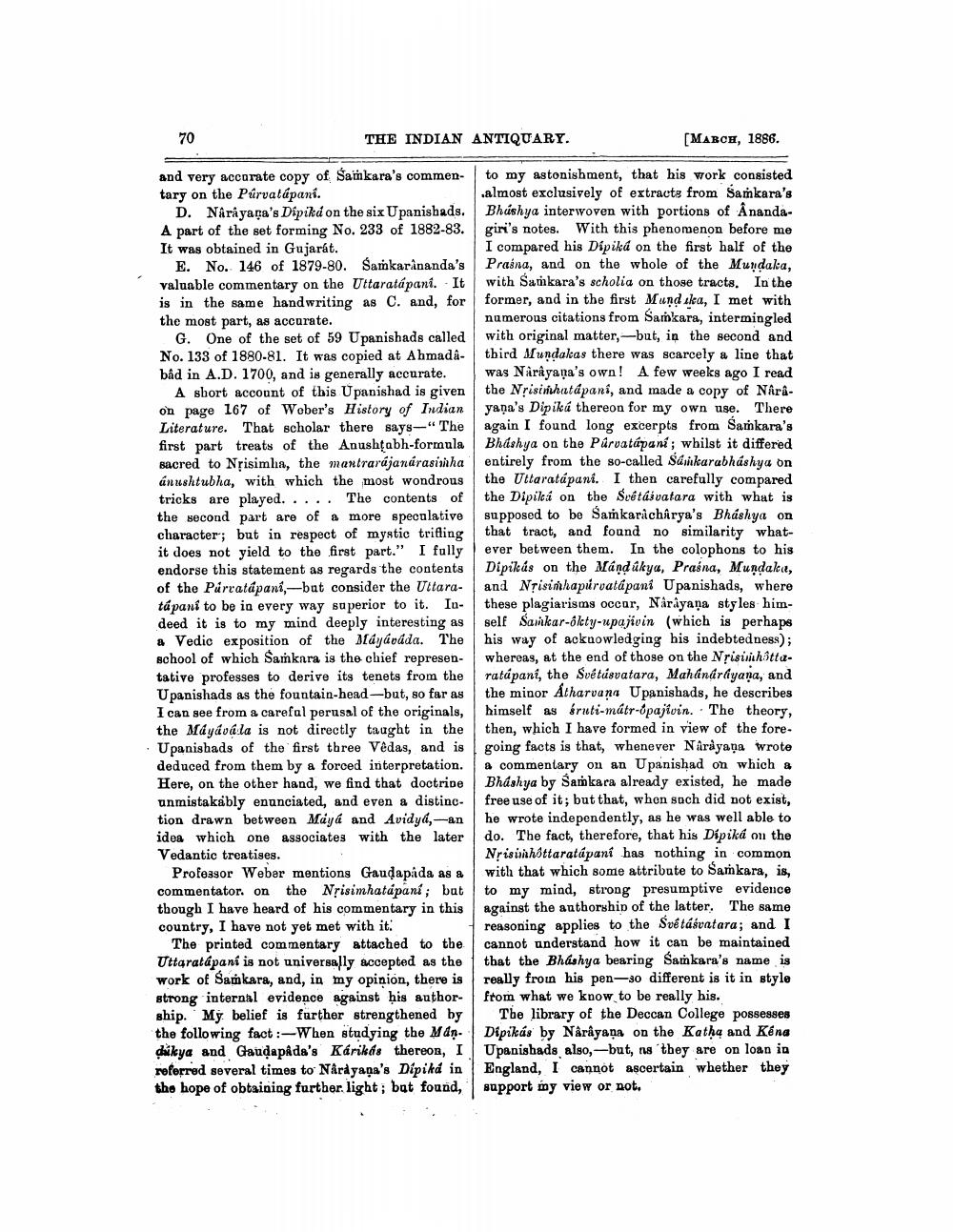________________
70
THE INDIAN ANTIQUARY.
and very accurate copy of Samkara's commentary on the Púrvatápaní.
D. Narayana's Dipikd on the six Upanishads. A part of the set forming No. 233 of 1882-83. It was obtained in Gujarát.
E. No. 146 of 1879-80. Samkarananda's valuable commentary on the Uttaratápaní. It is in the same handwriting as C. and, for the most part, as accurate.
G. One of the set of 59 Upanishads called No. 133 of 1880-81. It was copied at Ahmadâbâd in A.D. 1700, and is generally accurate.
A short account of this Upanishad is given on page 167 of Weber's History of Indian Literature. That scholar there says "The first part treats of the Anushtabh-formula sacred to Nṛisimha, the mantrarájanarasimha ánushtubha, with which the most wondrous tricks are played. . . . . The contents of the second part are of a more speculative character; but in respect of mystic trifling it does not yield to the first part." I fully endorse this statement as regards the contents of the Púrratápaní,-but consider the Uttaratúpaní to be in every way superior to it. Indeed it is to my mind deeply interesting as a Vedic exposition of the Máyáváda. The school of which Samkara is the chief representative professes to derive its tenets from the Upanishads as the fountain-head-but, so far as I can see from a careful perusal of the originals, the Máyávala is not directly taught in the Upanishads of the first three Vêdas, and is deduced from them by a forced interpretation. Here, on the other hand, we find that doctrine unmistakably enunciated, and even a distinction drawn between Maya and Avidya,-an idea which one associates with the later Vedantic treatises.
[MARCH, 1886.
to my astonishment, that his work consisted .almost exclusively of extracts from Samkara's Bhashya interwoven with portions of Anandagiri's notes. With this phenomenon before me I compared his Dipika on the first half of the Praina, and on the whole of the Mundaka, with Samkara's scholia on those tracts. In the former, and in the first Mundika, I met with numerous citations from Samkara, intermingled with original matter,-but, in the second and third Mundakas there was scarcely a line that was Narayana's own! A few weeks ago I read the Nṛisimhatápaní, and made a copy of Nârâyana's Dipika thereon for my own use. There again I found long excerpts from Samkara's Bhashya on the Pârvatápaní; whilst it differed entirely from the so-called Samkarabhashya on the Uttaratápani. I then carefully compared the Dipika on the Svétásvatara with what is supposed to be Samkaracharya's Bhashya on that tract, and found no similarity whatever between them. In the colophons to his Dipikus on the Mándûkya, Praśna, Mundaka, and Nṛisimhapurvatapani Upanishads, where these plagiarisms occur, Narayana styles himself Samkar-ôkty-upajivin (which is perhaps his way of acknowledging his indebtedness); whereas, at the end of those on the Nrisimhottaratápaní, the Svétásvatara, Mahanarayana, and the minor Atharvana Upanishads, he describes himself as śruti-mátr-ópajivin. The theory, then, which I have formed in view of the foregoing facts is that, whenever Narayana wrote a commentary on an Upanishad on which a Bhashya by Samkara already existed, he made free use of it; but that, when such did not exist, he wrote independently, as he was well able to do. The fact, therefore, that his Dipika on the Nrisimhottaratápaní has nothing in common with that which some attribute to Samkara, is, to my mind, strong presumptive evidence against the authorship of the latter. The same reasoning applies to the Svétásvatara; and I cannot understand how it can be maintained that the Bhashya bearing Samkara's name is really from his pen-30 different is it in style from what we know to be really his.
Professor Weber mentions Gauḍapida as a commentator. on the Nṛisimhatápaní; but though I have heard of his commentary in this country, I have not yet met with it.
The printed commentary attached to the Uttaratápaní is not universally accepted as the work of Samkara, and, in my opinion, there is strong internal evidence against his authorship. My belief is further strengthened by the following fact:-When studying the Man. dikya and Gaudapada's Kárikás thereon, I referred several times to Narayana's Dipiká in the hope of obtaining further. light; but found,
The library of the Deccan College possesses Dipikás by Narayana on the Katha and Kena Upanishads also,-but, ns they are on loan in England, I cannot ascertain whether they support my view or not.




